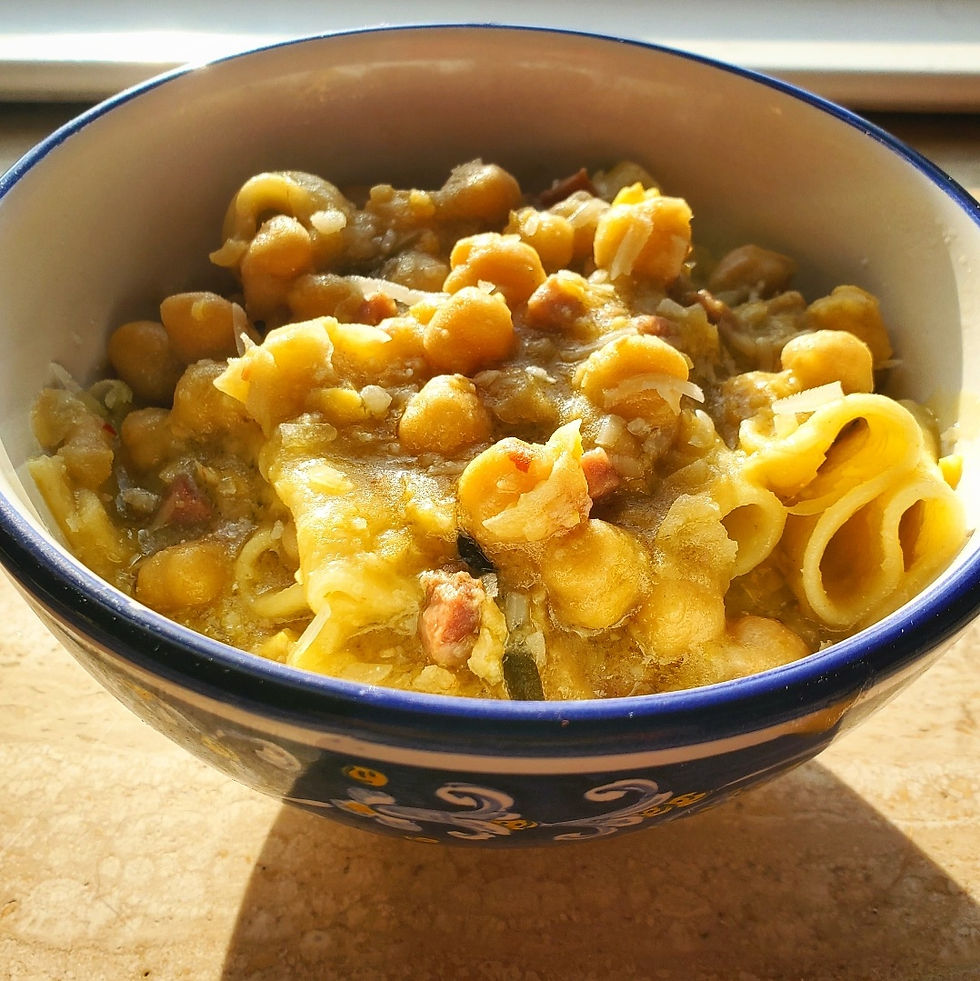A dish steeped in history: Lagane e Ceci
- Mangia McCann
- May 9, 2023
- 3 min read
2023 Giro d’Italia - Stage 4: Venoso to Lago Laceno
While the riders traversed 4 different regions yesterday, they settled down today, starting in Basilicata and ending in Campania. The Giro’s official website noted that the signature dish of Venoso by referencing this historical text: inde domum me ad porri et ciceris refero laganique catinum (I am going home to my bowl of leeks, chickpeas, and lagane) which was written by Horace when he was 30 years old…in 35 B.C.! This line was his way of trying to distinguish himself as more a Freeman (he was born free, but his father was a Freeman - one who was once a slave) as opposed to a Roman politician or other aristocrats with whom he associated with during his time in Rome and Athens. This meal is humble, historical, and heartily satisfying.

Lagane e Ceci
1 lb bag of chickpeas
~½ cup extra-virgin olive oil
4 oz diced pancetta
1 leek, white and light green part only, halved, cleaned and sliced ¼”
4 garlic cloves, peeled and smashed
Heavy pinch of pepper flakes
Rosemary sprig
2 bay leaves
⅔ cup each of 00 and fine semolina flour (or 1 ⅓ cup AP flour)
2 eggs
Pecorino Romano
Soak the chickpeas overnight in a bowl full of water.
The next day, pour just under ¼ cup of oil into a medium dutch oven. Turn the heat to medium-high and add in the pancetta, leeks, and garlic.
Drain the chickpeas.
When the pot contents start sizzling, add in the pepper flakes and cook for about a minute to warm them up. Then stir in the chickpeas.
Add in the rosemary and bay leaves, and 8 cups of water. Bring to a boil and cook for 5 minutes, then lower the heat to maintain a steady simmer. Cook, uncovered, for an hour, even up to 90 minutes, stirring occasionally.
Meanwhile, make the pasta by adding the flour and 1 tsp of salt in a food processor. Beat the eggs with a splash of water and olive oil and a pinch of salt.
Run the food processor for about 5 seconds, then add in the egg mixture. Process until the dough comes together.
Dump the dough ball onto a lightly floured work surface and knead for about 5 minutes until smooth. Wrap in plastic cling wrap and leave on the counter until the beans have cooked for an hour.
Once the beans have cooked for 45 minutes, bring a pot of water to a boil, season heavily with salt, and allow to return to a boil. Hold, covered until the beans are nearly ready. The beans should have a slight bite to them (al dente) with a creamy interior texture.
Divide your pasta dough in half. Roll each portion into a ball then pat into a rough square. Dust the pasta with some flour then run it through the widest setting of your pasta roller. Fold the pasta ends towards the middle and run through the rollers again; repeat once more. Dust the pasta sheet with more flour and continue to run through the pasta rollers, adjusting the rollers closer and closer, ending on setting 5 (I have a Kitchen Aid). Lay the pasta sheets on a flour dusted surface.
Using a large chef’s knife, cut the past sheets in half. Turn the pasta sheet sideways, long edge facing you, short ends to the sides. Using the knife, cut the pasta into roughly 1” wide slices.
Add all of the cut pasta to the boiling water and cook for a few minutes.
While the pasta cooks, remove the bay leaves and rosemary sprig from the pot. Taste for a ny seasoning needs. Using a stick blender, pulse the bean mixture 8-12 times, slightly thickening the soup. Pour in some olive oil and mix together.
Drain the pasta, using a spider or kitchen tongs, and place into the pot of chickpeas, stir until combined. Cook over low heat for a minute or so.
Meanwhile, grate about a cup of Pecorino Romano. Add most of it to the pot, turn off the heat and mix together, adding some pasta water if necessary.
Serve in bowls, topping with more cheese and a drizzle of oil.
______________________________ Copyright 2023, Brendan McCann, All Rights Reserved.



Opmerkingen